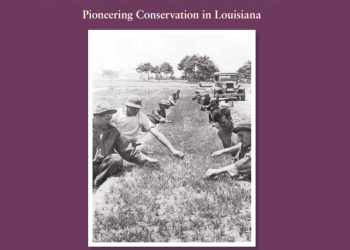Discover History
The Kisatchie National Forest is rich in history - from its beginning to the present. From historic military training camps, sawmill towns, to Civilian Conservation Corps projects, Kisatchie's lands have seen a variety of purposes over the years.
History of the Kisatchie
The name Kisatchie was derived from a tribe of Kichai Indians of the Caddoan Confederacy, who called themselves "Kitsatchie." In the late 1800's virgin forests covered 85 percent of Louisiana. Not only was most of the land in timber, much of it was in pure stands of magnificent yellow pine. The quality, volume and level terrain represented a lumberman's dream. And they reaped that dream in the short span of roughly 25 years.
Those outstanding forests enabled Louisiana to lead the nation in lumber production in 1914 and ranked second for several years. But that fast cut-out-and-get-out practice left Louisiana a blackened stump-waste just as the Great Depression gripped the nation. Devoid of resources or hope, few people saw any future for Louisiana in timber.
The Great Depression affected people of Louisiana long before the fateful "Black Tuesday" of October 29, 1929. The economic woes came several years before 1929 when the majority of large sawmills started closing their doors. The largest sawmill west of the Mississippi River, the Gulf Lumber Company, cut its last timber in 1927 due to the economic ills of the country.
Fortunately for Louisiana, the Forest Service was able to acquire some of the Gulf Lumber Company and others lands. But as records of the supervisor's office show, there were over 78 large abandoned mills in western and north central Louisiana scattered throughout 26 pine parishes. During its first 30 years, the Kisatchie acquired land in only five of those parishes: Vernon, Rapides, Grant, Natchitoches and Winn. Even at bargain offers of less than $2 per acre, the federal government was limited in its purchases. The depressed economy was also pinching federal budgets and funds were not always available.
As the nation slipped deeper into the throes of the Depression, President Hoover stood staunchly by his belief in private enterprise and against public welfare and relief programs. But in 1929 the Forest Service was able to hire a few local men to begin management work on Kisatchie National Forest purchase units.
In 1928, Charles A. Plymale had been assigned as head of the Kisatchie Purchase Unit with headquarters in Alexandria, Louisiana. The following year the Forest Service Directory for October, 1929, listed the Catahoula as the forest's first ranger district. P.E. Ackerman headed that unit with his headquarters at Pollock, Louisiana. In 1930 the current Secretary of Agriculture Hyde proclaimed the Kisatchie as a National Forest.
Today Louisiana is green again, and the state's only national forest, the Kisatchie, is considered a forester's dream. In 1979 and 1980, it led all other national forests of the South in revenue produced per acre.
For more information on the Historic Native Americans that lived in the areas that are now Kisatchie National Forest, please refer to Archaeology and Cultural Resources.
A History of the Kisatchie National Forest

The past, present, and future of the Kisatchie and Louisiana are woven together with the strong bond of sustained-yield forestry that supports more jobs than any other resource-related field besides the petrochemical industry. Yet the general public is often unaware of the important role Louisiana's national forest plays in the state's economy or how the quality of life for its citizens is enhanced. The basic purpose of this study is to tell the remarkable history of the Forest Service's achievements on the Kisatchie, and to help preserve the forest's heritage along with that of Louisiana. Written by Dr. Anna C. Burns
Remembering the Sacrifice - Historic Camp Claiborne

In 1940, construction began on numerous military installations in central Louisiana that would train millions of young men and women entering the U.S. Army for service during World War II. Over 500,000 troops trained at Camp Claiborne alone during its 6 years of existence. Many of the units which trained there became the most decorated during World War II and suffered heavy casualties in combat around the world. It is now 75 years after the establishment of Camp Claiborne. We need to continue to remember the sacrifices of all those who served with dedication, commitment, and valor. Written by Dr. James P. Barnett, Douglas J. Rhodes, and Lisa W. Lewis.
Caroline C. Dormon - the "Mother" of Kisatchie

Caroline C. “Carrie” Dormon was a renowned forest conservationist and one of the most influential American naturalists of the early 20th century. In an era when women had no role in forestry, she led the effort to establish the Kisatchie National Forest, developed forestry education materials for schools, and promoted support for forestry among civic and community leaders. In addition to her passion for forestry, Carrie advocated education and support for indigenous peoples, wrote important books and articles on native plants, promoted highway and landscape beautification using native plants, cultivated and hybridized native irises, and led the establishment of a State arboretum. This is her story as written by Dr. James P. Barnett and Sarah M. Troncale.
Civilian Conservation Corps in Louisiana

The Civilian Conservation Corps (CCC) was a public work relief program that operated from 1933 to 1942 in the United States for unemployed, unmarried men from relief families, ages 18-25. A part of the New Deal of U.S. President Franklin D. Roosevelt, it provided unskilled manual labor jobs related to the conservation and development of natural resources on the Nation’s forest and agricultural lands. Men enrolled in the CCC planted over 2 billion trees, built over 125,000 miles of roads and trails, constructed over 6 million erosion control structures, and spent 6 million workdays fighting forest fires. (No women were ever enrolled in the CCC.) Written by Dr. James P. Barnett and Dr. Anna C. Burns.



